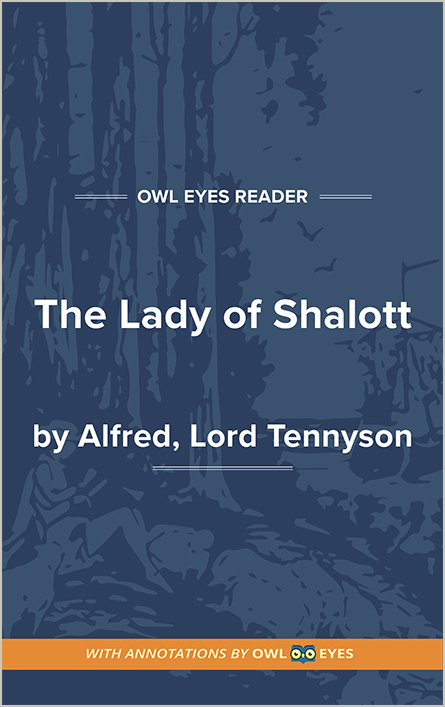Analysis Pages
Themes in The Lady of Shalott
The Victorian Ideal of Womanhood: In many ways, the Lady’s situation is evocative of the status of women in Victorian England and subtly criticizes their lack of agency. The image of a lady in a tower acts as a metaphor for the woman who is locked away from society in order to protect her purity. The Lady’s options in the poem amount to either remaining in the tower, lonely and “half-sick of shadows,” or risking a curse through interacting with society. The scene where the Lady looks out at Lancelot can be read as her proverbial “fall from grace.” Just as the slightest rumor of impropriety would have resulted in social ruin for a Victorian woman, the Lady dies for her small exertion of choice and curiosity.
The Isolated Artist and Society: The place of the artist in society has long been debated, and one recurring trope is that art thrives in isolation and is sullied by social interaction and obligation. The Lady of Shalott can be seen as an artist, for she creates a “magic web,” or tapestry, based on the sights she sees in her mirror. At the beginning of the story, she “delights” in this work and has no other cares but her art. However, as the story progresses, she begins to express her dissatisfaction with her isolation and grows “half-sick of shadows”—sick of creating images of life without actually participating in it. She eventually looks out at Camelot only to have her art fly out the window, symbolizing the central conflict between the artist’s need for solitude and the human desire for connection.
The Supernatural: Though the source is never explicitly defined or acknowledged, the poem contains a supernatural undercurrent. The Lady’s life is ruled by a curse of unknown origin that forbids her from interacting with the world outside of her tower. She spends her days weaving a “magic web” based on the sights she sees in her mirror, a kind of supernatural craft. In both instances in which someone directly reacts to the Lady, it is with a sense of fear or awe: the reapers dub her a “fairy” and the knights of Camelot cross themselves out of fear. The perception of the supernatural serves as a barrier between the Lady and human connection, isolating her not only physically but also conceptually.
Freedom Comes at a Cost: Regardless of the lens with which readers approach “The Lady of Shalott,” the concept of freedom is a recurrent end goal. The Lady is isolated in a tower and subject to a curse that tells her she cannot look at Camelot except in her mirror. The essential idea is that she is restricted, unable to pursue something that she wants. The price of looking out the window at Camelot, as the Lady finds out, is death. Whether it is the Victorian woman seeking social agency, the artist reaching for human connection, or an ostracized person looking for social acceptance, the choice is the same: remain safely ensconced in the lonely tower, or chase freedom at the cost of life itself.
Themes Examples in The Lady of Shalott:
Text of the Poem
🔒"She knows not what the curse may be..." See in text (Text of the Poem)
"Dead-pale..." See in text (Text of the Poem)
"She loosed the chain, and down she lay;..." See in text (Text of the Poem)
"Camelot: ..." See in text (Text of the Poem)
"God in His mercy lend her grace, 170 The Lady of Shalott."..." See in text (Text of the Poem)
"they cross'd themselves for fear,..." See in text (Text of the Poem)
"they read her name..." See in text (Text of the Poem)
"Out flew the web ..." See in text (Text of the Poem)
"She looked down to Camelot...." See in text (Text of the Poem)
""I am half sick of shadows,"..." See in text (Text of the Poem)
" she still delights To weave..." See in text (Text of the Poem)
"the river eddy whirls. ..." See in text (Text of the Poem)
"look down..." See in text (Text of the Poem)
"if she stay..." See in text (Text of the Poem)
"“’Tis the fairy 35 Lady of Shalott."..." See in text (Text of the Poem)
"Or is she known in all the land..." See in text (Text of the Poem)
"the silent isle imbowers..." See in text (Text of the Poem)
"lilies..." See in text (Text of the Poem)
"a glassy countenance..." See in text (Text of the Poem)
""The curse is come upon me,"..." See in text (Text of the Poem)
"the helmet and the plume..." See in text (Text of the Poem)
"Came two young lovers lately wed;..." See in text (Text of the Poem)
"Pass onward..." See in text (Text of the Poem)
"She has heard a whisper say, A curse is on her..." See in text (Text of the Poem)

